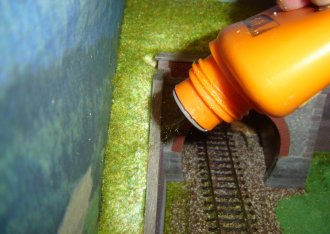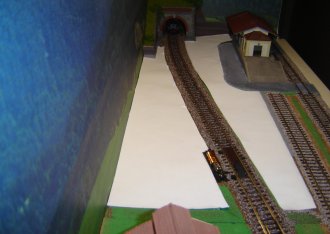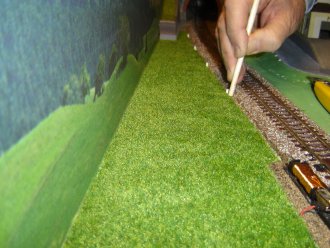

zoom
 zoom
zoom


zoom
 zoom
zoom

| One to eighty seven (8) |
|
Taking into consideration that Enrico had other things to do during the holidays, I decided to correct one of the design errors which I will later describe in the section “in hindsight”. That fixed panel had to be opened! I would have preferred to cut up the vertical plane but the inside of the structure is robustly reinforced and this meant that I would have to effect the cut some 3cm from the edge. Not wanting to damage the cabinet with undue vibration the only thing that came to mind was to undertake a job that would have tested the patience of Job. The first thing to do was to delineate the area to be removed by means of a series of holes made with a small awl. The second phase was to drill and drill and drill these prepared holes with a 1.2mm bit followed immediately by a 3mm. one. When all the holes had been drilled the piece fell out by itself. Looking inside I almost surprised myself to see how I had been able to install those three Tortoise motors working from a totally offset position! In the last stages of the present job the chamfering of the edges to 45° to take the frame took me a long time, but now looking at the end result I can be reasonably pleased even if I fervently hope never to have to open it again! The panel is only pushed into position and blocked on the outside by the frame itself whilst on the inside there are two small clasps easily unblocked from the inside. The main thing is that now 95% of the electrical plant is now easily reachable. (see inside). |
2007 December

zoom  zoom
zoom
|


zoom  zoom
zoom
|
|
I had not originally planned to put lights into the buildings but then at Christmas, when my grand-daughter asked me, “Grandad, why aren't there lights in the windows?” I changed my mind. I thought that after all the job would not be too complex, so I went out and bought some small bulbs, and for each building to illumine, after having positioned a small tubular cable I connected the light bulbs trying as far as possible to keep the lights as central as I could. Later some openings will be screened off in order to let the light shine out from some selected rooms and not all. |
2008 January

|
|
It was not easy finding that which I wanted. The lamp-posts I was looking for had to be exactly as I remembered them many years ago when I saw them in a small station in the country. I showed an old photograph to those who I thought could have helped me in my search but it appeared that nothing was commercially available that approximated to the Italian style and date of the artefacts. Then I trusted to the Internet and one fine day, with great surprise, I found exactly that for which I had been looking. Near Montecatini there is a shop for modellers and reading through the heading accessories, after the usual Brawa lamp-posts, mine appeared. The following day I was inside the shop. The lamp-posts are hand-made by an artisan from Lombardy and there were only four available. Now they are mine and cut a fine figure on the station's platform. Later, when the details will have been completed I will publish some night-time photographs. |


zoom  zoom
zoom
|
|
The choice and the laying down of the green areas is fairly important as an eventual undervaluation would seriously compromise the realistic effect so much sought after. The visible part of the model consists of an area of train track about 250m. by 32m. With the exception of some rare instances and localised in precise areas of the village, for the chosen ambience I cannot really think of a single uniform colour for the various areas of the land adjacent to the tracks. Besides, for the time scale I have in mind for the model, I well remember the care taken by the railway service for land for which they were responsible and the contrast with the areas surrounding and adjacent to railway property (often untidy and neglected). These considerations therefore conduct one to the search for a logical differencing of structure, type and colouring of the terrain and of the green areas. For this reason also the materials and techniques used for the laying down of the said areas are different. Not wishing to undertake a lengthy description of all the various operations, I think that it is probable better to describe a few particulars relative to differing areas. |


|
|
For the tunnel, after having spread a goodly dose of the classic Vinavil with the addition of 20% water, the grass (Woodland Scenic) is sprayed in abundance with the given applicator. Immediately afterwards the excess is hoovered up to leave just a carpet which is perfectly anchored. |
2008 February

|


|
|
In the short distance between the tunnel and the entry into the station before laying down the chosen grass, it was necessary to prepare cardboard models to help the cutting process. Two types of grass were used, both Bush products. The external part is lighter in colour than the internal part, as I wanted to get as close as I could to the colouring of the background. |


|


|
|
Given that there were the seven points levers I needed available in the shop where I had bought the lamp-posts, it was very important for me to get them into position before getting down to the details I had in mind for the areas adjacent to the points themselves. I do not know if these were the best that are commercially available, but they are the best I have seen up to date. From the many pictures I had seen on the Internet I realised that not all points levers were exactly the same, nor were they conform to a given standard. The photo that more than any other seemed to clear up any doubts I may have had on the eventual installation of these objects (which were no other than a lever which allowed the manual switching of the points on the track) served me as a basis on which to plan the way of placing the small metal kit into position. Simple to construct but somewhat tricky to install. For each lever I had to cut out the necessary space besides the points, then prepared three extensions of the interested sleepers, and after having newly filled in the spaces with gravel, I glued the base of the lever into the seats I had created in the extension of the sleepers. |


zoom  zoom
zoom
|


zoom  zoom
zoom
|
< < < < <
Previous
 Onetoeightyseven
Onetoeightyseven
 Next
> > > > >
Next
> > > > >
|